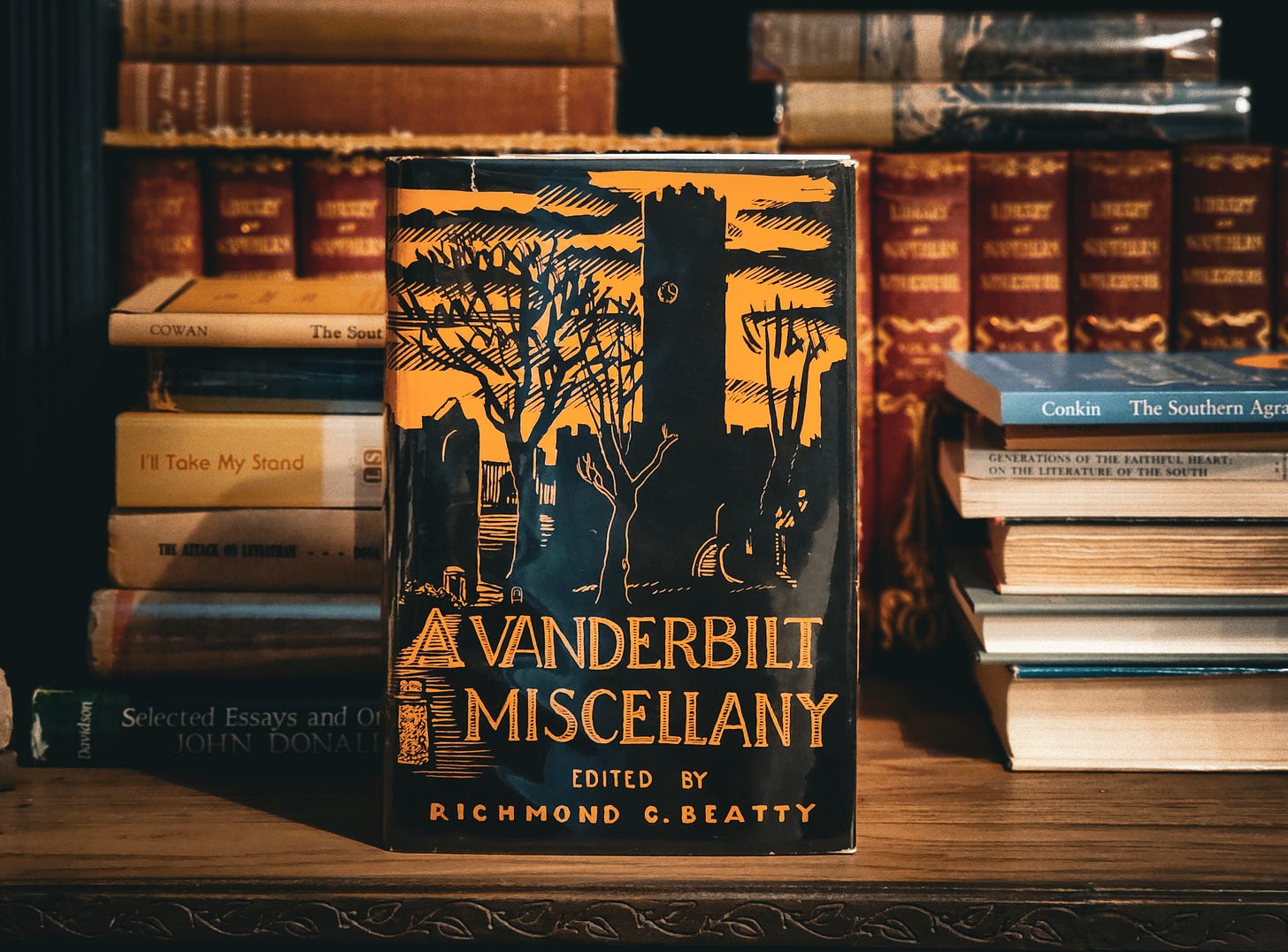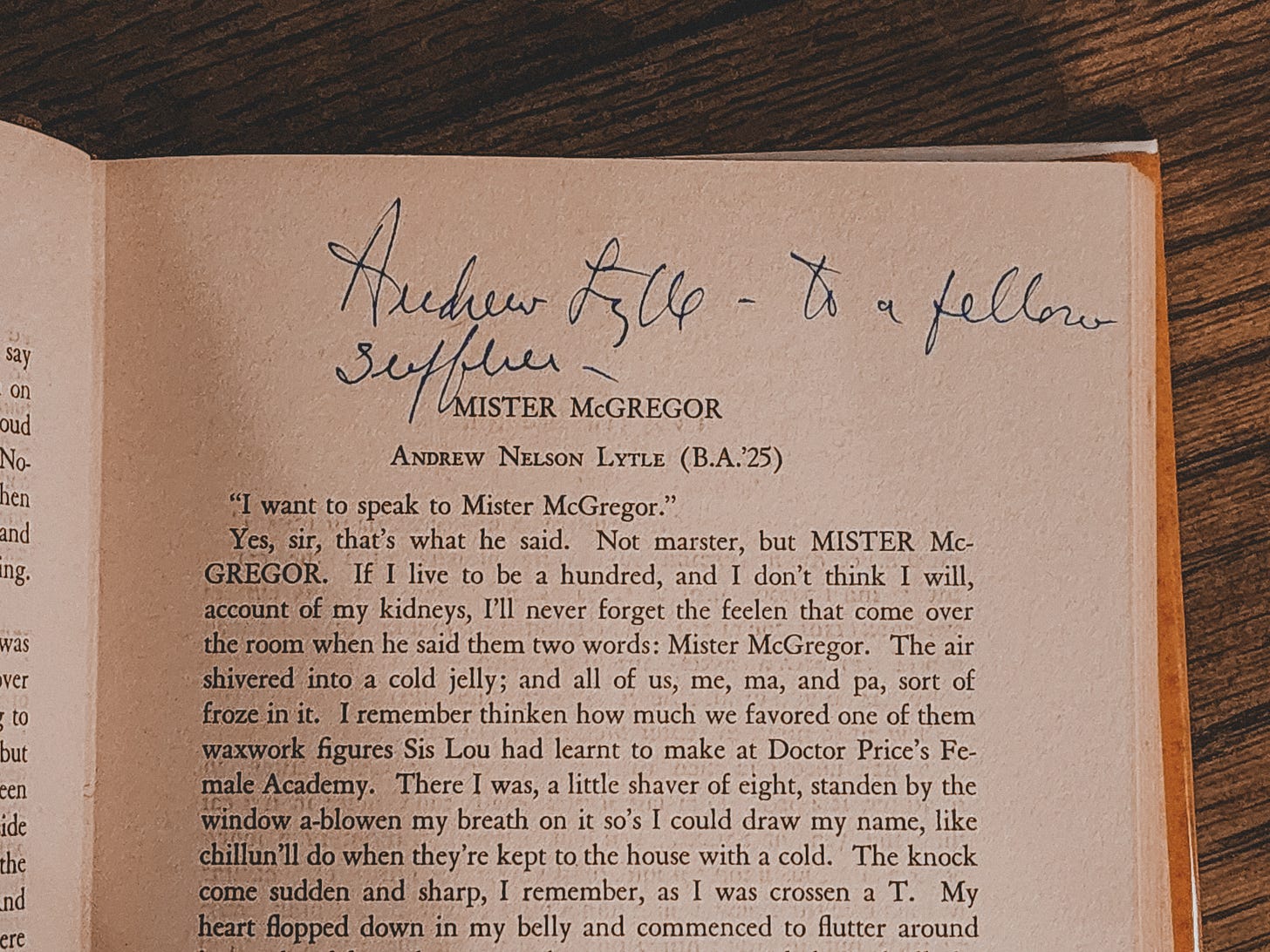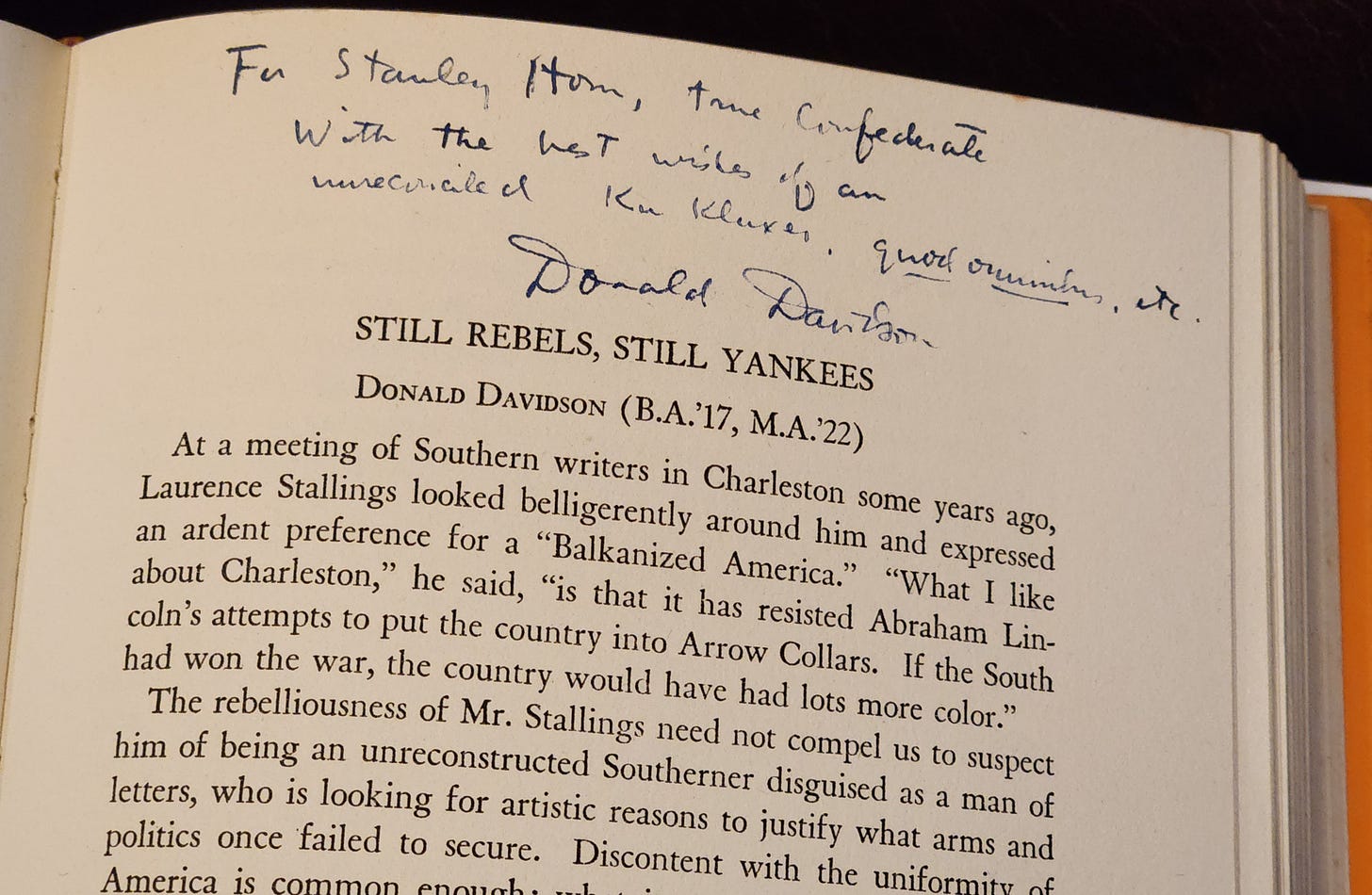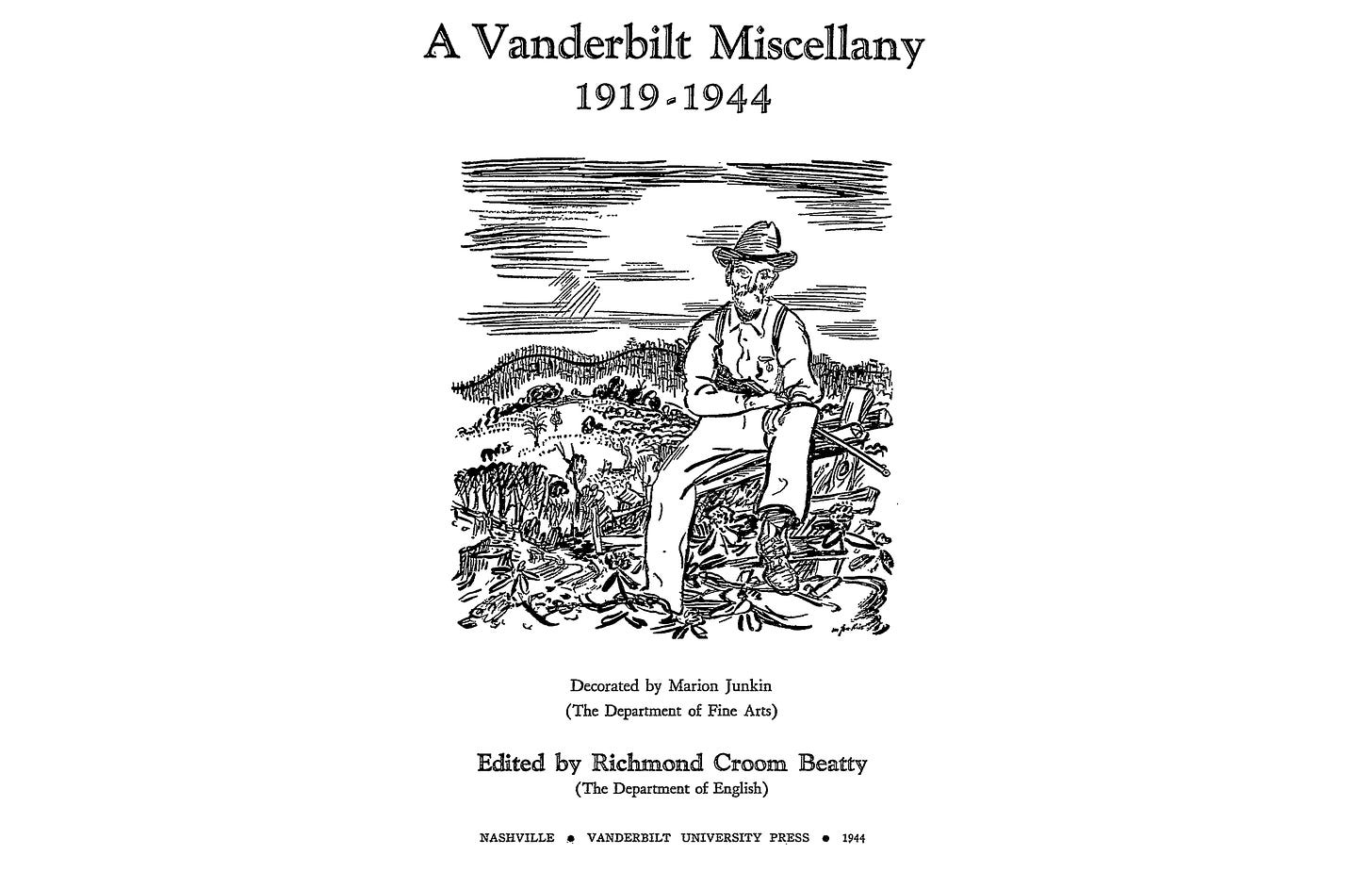From the Shelves: A Vanderbilt Miscellany, 1919-1944
When you spend hours each week trawling through AbeBooks, Biblio, and the Internet Archive, you pick up a thing or two. I'm always a bit taken aback when a digital copy of a book isn't on the Archive or other ebook/pdf sites. Stranger still is when you can't find a physical copy of a book you need like The Sword Was Their Passport, A History of American Filibustering in the Mexican Revolution by Harris Gaylord Warren, published in 194 by Louisiana State University Press. But let's not wander off track.
A Vanderbilt Miscellany, 1919-1944 hadn’t been archived. That’s been set right. Now, before I comment on the archived volume, let me tell of another. Sometimes, I sit just staring at it, shaking my head, a bemused smile creeping in, muttering like Gollum with his precious, though I've never been one for trinkets. Ah, but my books! A few are held dearer than the rest.
The it: Stanley Horn’s personal copy of Vanderbilt Miscellany. Horn, a man deeply devoted to preserving the past and gathering its artifacts, left behind a remarkable collection. Today, much of what he cherished finds its home at the Heard Library at Vanderbilt. Not only was it Horn’s copy (whose work I collect), it just so happens to be signed by Richmond Croom Beatty, Andrew Lytle, George Pullen Jackson, Frank L. Owsley, Donald Davidson, Alec Brock Stevenson, Marion Montague Junkin (Illustrator), H. Clarence Nixon, Ethel Moore, and Mildred Haun.
But wait, there's more. Signatures from Beatty, Nixon, Stevenson, and Owsley adorn their contributions. Lytle inscribed his contribution “to a fellow sufferer.”
The detail that elevates this volume is the personal inscription by Donald Davidson:
For Stanley Horn, true Confederate With the best wishes of an unreconciled Ku Kluxer, quod omnibus, etc.
Enough about my shelves. Over to the archives. The copy that someone (probably a handsome Tennessean) archived was owned by Brigadier-General Harold Albert Nisley (1892–1963), an Ordnance Officer in WWII. He also wrote essays like “The Relation Between the Dynamic and the Static Tensile Tests”. Here’s his obituary from the Tennessean.
The Book
You might be asking, “Why should I care about this book?” Fair question. First, the metadata:
Main Title: A Vanderbilt Miscellany, 1919-1944
Published/Created: Nashville, Vanderbilt University Press, 1944.
LC Classification: PS536 .B47
LC Subjects: American literature--20th century. American literature--Southern states. Southern States--Literary collections.
Were this book a statue, it would be melted down, reshaped into a [redacted], and auctioned off at a “banned books” event. Don’t believe me? Let’s head on over to the Vandy Press blog, where a gatekeeper “reflects on the checkered legacy of one of VUP’s most important books in our 80-year history: A Vanderbilt Miscellany.”
The Commie, I mean Commodore continues:
“All these literary deities brought together in this volume supported by the Board and published by us. This volume helped set the course of the Press. It helped cement our reputation for publishing important, vital scholarship. All the beautiful words in it were devoted to celebrating and eulogizing the legacy of the white supremacist South.
The hard question remains: What is the legacy of A Vanderbilt Miscellany for the Press? We would never publish a book like this now. At the least, we’d expect a book devoted to the best of Vanderbilt to represent Vanderbilt’s current commitment to diversity. And, frankly, we just wouldn’t publish a book that uncritically presented a poem in honor of Nathan Bedford Forrest and his role in the Ku Klux Klan. We aren’t that kind of Press anymore.
But at one point, we were. And if we want to celebrate 80 years of publishing, we have to acknowledge our grave missteps—A Vanderbilt Miscellany being among our worst.”
You know the saying, “one man's trash is another man's treasure.” I believe that amassing and digitizing books that couldn’t be published in our current climate is a commendable quest. Back to the book.
A Little History
In September 1942, H.C. Nixon took the helm of the Vanderbilt University Press. The press was launched in November 1940 for the Institute of Research and Training in the Social Sciences. In his first year, Nixon published numerous works and the paper Freight Rates and the South, which caught on regionally, selling nearly two thousand copies. Nixon furthered the press's renown by arranging A Vanderbilt Miscellany, edited by Professor Richmond C. Beatty. Nixon, Beatty, and Donald Davidson curated the anthology of Vanderbilt faculty writings from 1918 to 1942. Chancellor Carmichael boasted, “Few universities in the country could duplicate such a publication.”1
Donald Davidson wrote that before the Southern “Renascence” was formally studied, Beatty, with his friend William Perry Fidler, had explored and anthologized it in Contemporary Southern Prose (1940). In his detailed introduction to A Vanderbilt Miscellany, which he largely planned and edited, Beatty penned the first authentic short history of the Fugitive group and Vanderbilt's literary scene over twenty-five years.2
Reception
In my reckoning, the Virginia Quarterly Review never missed a chance to take shots at the Agrarians whenever they were within reach, which Herschel Brickell seems to do in his review. I’ve archived a collection of newspaper reviews and relevant clippings for your reading pleasure.
Cheers!
Related
Shouse, Sarah N.. Hillbilly Realist: Herman Clarence Nixon of Possum Trot. University of Alabama Press, 1986, pp 152-153.
“Richmond Croom Beatty: A Memoir” in Reality and Myth: Essays in American Literature in Memory of Richmond Croom Beatty. Vanderbilt University Press, 1964. p. 13.













Next time I’m in Nashville you and I are sitting down and you are sharing methods for I can do this for the Midwest.
That VU Press blog post is a trip. Written in June 2020! How elated the author must have been when she realized the 80th anniversary had timed perfectly with The Racial Reckoning. Yet you can tell she hadn’t yet picked up all the subtleties. Black is not capitalized and she published on June 10th but does not mention the new Holy Day of Obligation only 9 days away.